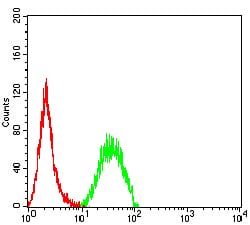

| WB | 咨询技术 | Human,Mouse,Rat |
| IF | 咨询技术 | Human,Mouse,Rat |
| IHC | 咨询技术 | Human,Mouse,Rat |
| ICC | 技术咨询 | Human,Mouse,Rat |
| FCM | 1/200 - 1/400 | Human,Mouse,Rat |
| Elisa | 1/10000 | Human,Mouse,Rat |
| Aliases | LLS; HYPB; SET2; HIF-1; HIP-1; KMT3A; HBP231; HSPC069; p231HBP |
| Entrez GeneID | 29072 |
| clone | 4G11E6 |
| WB Predicted band size | 287.6kDa |
| Host/Isotype | Mouse IgG1 |
| Antibody Type | Primary antibody |
| Storage | Store at 4°C short term. Aliquot and store at -20°C long term. Avoid freeze/thaw cycles. |
| Species Reactivity | Human |
| Immunogen | Purified recombinant fragment of human SETD2 (AA: 2054-2245) expressed in E. Coli. |
| Formulation | Purified antibody in PBS with 0.05% sodium azide |
+ +
以下是关于SETD2抗体的3篇代表性文献,简要总结如下:
1. **文献名称**:*SETD2 deficiency induces chromosomal instability via impaired DNA damage repair in renal cancer*
**作者**:Wang et al.
**摘要**:该研究利用SETD2特异性抗体(Western blot和免疫荧光)分析肾癌细胞系,发现SETD2缺失导致DNA损伤修复异常,进而引发染色体不稳定性和肿瘤进展。研究揭示了SETD2通过调控H3K36me3修饰维持基因组稳定性的机制。
2. **文献名称**:*The histone methyltransferase SETD2 is required for expression of tumor suppressor genes in acute myeloid leukemia*
**作者**:Pfister et al.
**摘要**:通过SETD2抗体(ChIP-seq和流式细胞术)发现,在急性髓系白血病中,SETD2通过催化H3K36me3修饰激活抑癌基因表达,其缺失与化疗耐药性相关,提示SETD2作为潜在治疗靶点。
3. **文献名称**:*Loss of SETD2 promotes aggressive breast cancer through epigenetic and transcriptional dysregulation*
**作者**:Park et al.
**摘要**:利用SETD2抗体(免疫组化和染色质分析)研究乳腺癌组织,发现SETD2缺失导致H3K36me3水平降低,进而引发致癌基因异常激活和上皮-间质转化(EMT),促进肿瘤侵袭转移。
4. **文献名称**:*SETD2 regulates the maternal epigenome, genomic imprinting and embryonic development*
**作者**:Yuan et al.
**摘要**:该研究使用SETD2抗体(免疫沉淀和全基因组测序)分析小鼠胚胎干细胞,证实SETD2通过H3K36me3修饰调控母源基因组印记和胚胎发育,其缺失导致早期胚胎致死。
---
以上文献均涉及SETD2抗体的实验应用(如检测蛋白表达、修饰或功能研究),并聚焦于SETD2在表观遗传调控、癌症及发育中的作用。
The SETD2 (SET Domain Containing 2) antibody is a crucial tool for studying the epigenetic regulator SETD2. a histone methyltransferase responsible for catalyzing trimethylation of histone H3 at lysine 36 (H3K36me3). This post-translational modification is associated with active transcription, DNA repair, and chromatin stability. SETD2 is the sole enzyme generating H3K36me3 in humans, linking it to diverse cellular processes, including mRNA splicing, replication fork dynamics, and tumor suppression.
Mutations or dysregulation of SETD2 are implicated in cancers, particularly clear cell renal cell carcinoma (ccRCC), pediatric high-grade gliomas, and leukemia. Loss-of-function mutations correlate with poor prognosis, underscoring its role as a tumor suppressor. Researchers use SETD2 antibodies in techniques like Western blotting, immunofluorescence, and ChIP-seq to investigate its expression patterns, subcellular localization, and interaction with chromatin.
Validating antibody specificity is critical due to potential cross-reactivity with other methyltransferases or epitope similarities. Commercial SETD2 antibodies often target distinct regions (e.g., N-terminal, catalytic SET domain, or C-terminal regions), enabling studies of domain-specific functions or truncation variants. Proper controls, including knockout cell lines or siRNA-mediated knockdown, are essential to confirm antibody reliability. These tools continue to advance our understanding of SETD2's role in epigenetics, disease mechanisms, and potential therapeutic targeting.
×